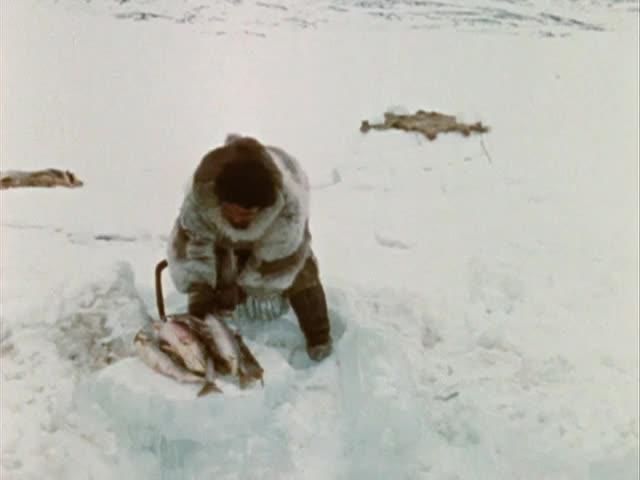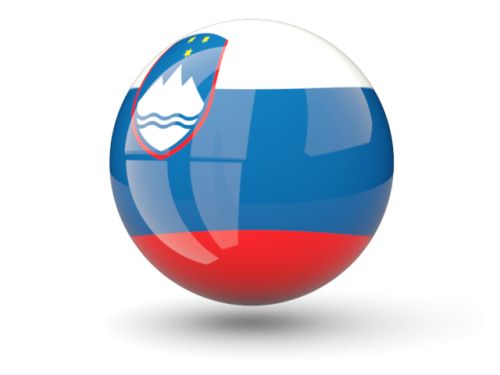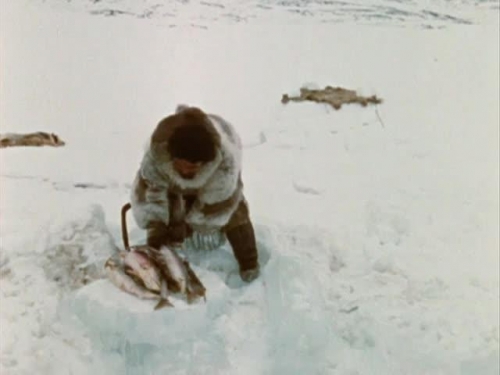


![]() Inuiti so bili zadnji domači ljudje, ki so prišli v Severno Ameriko. Vso dobro deželo na jugu so že zasedli sovražni Indijanci, tako da so se naselili na Arktiki. Nihče drug ni to želel, ker je bilo tam eno najbolj ekstremnih podnebij na svetu. Toda Inuiti so bili mojstri v prilagajanju svojih ljudi za trajnostno bivanje v ekstremnih pogojih že več tisoč let.
Inuiti so bili zadnji domači ljudje, ki so prišli v Severno Ameriko. Vso dobro deželo na jugu so že zasedli sovražni Indijanci, tako da so se naselili na Arktiki. Nihče drug ni to želel, ker je bilo tam eno najbolj ekstremnih podnebij na svetu. Toda Inuiti so bili mojstri v prilagajanju svojih ljudi za trajnostno bivanje v ekstremnih pogojih že več tisoč let.
Inuit je živel na območju, ki je obsegal velik del severne zemlje, vključno s severno Kanado, Aljasko, Grenlandijo in Sibirijo.
Jeziki Inuitov so lahko razdeljeni na več jezikov in narečij. Vendar pa vsi inuitski jeziki prihajajo iz ene glavne jezikovne družine: Inuit-Aleut. Jezikovna družina je poznana tudi pod imenom Eskimaleut.
Skupine jezikov je mogoče združiti v vzhodno vejo in zahodno vejo, ki se nato lahko razdeli na posamezne jezike in narečja teh jezikov.
Vzhodna veja (Inuktitut jeziki):
- Jeziki vzhodne veje imajo tri različna imena za jezik.Obstajajo tri različna imena, vendar se šteje, da so isti jezik.
- Inuktitut (v Kanadi)
- Inupiaq (na Aljaski)
- Kalaallisut (na Grenlandiji)
- Obstajajo tri različna imena, vendar se šteje, da so isti jezik.
- Obstajajo tudi številna narečja iz te jezikovne veje, ki se govorijo v treh državah.
Zahodna veja (Yupik jeziki):
- Yupik je razdeljen na tri različne jezike. Vsak od teh treh jezikov ima tudi več narečij.
- Centralni Aljaški Yupik
- Pacifiški Zalivski Yupik (Aljaska)
- Sibirski Yupik (Kanada in Aljaska)
- Vsak od teh treh jezikov ima tudi več narečij.
Jezika Inuktitut in Yupik sta zelo težka za učiti in govoriti, ker sta zelo kompleksna jezika.
![]() The Inuit were the last native people to arrive in North America. All the good land to the south was already occupied by hostile Indians so they settled in the Arctic. Nobody else wanted it because it was one of the most extreme climates in the world. But the Inuit were masters at adapting to sustain their people over thousands of years. The Inuit lived in an area comprising a large part of northern Earth, including Northern Canada, Alaska, Greenland, and Siberia. The languages of the Inuit can be divided into many different languages and dialects. However, all of the Inuit languages come from one main language family: the Inuit-Aleut, also known as the Eskimaleut language family.
The Inuit were the last native people to arrive in North America. All the good land to the south was already occupied by hostile Indians so they settled in the Arctic. Nobody else wanted it because it was one of the most extreme climates in the world. But the Inuit were masters at adapting to sustain their people over thousands of years. The Inuit lived in an area comprising a large part of northern Earth, including Northern Canada, Alaska, Greenland, and Siberia. The languages of the Inuit can be divided into many different languages and dialects. However, all of the Inuit languages come from one main language family: the Inuit-Aleut, also known as the Eskimaleut language family.
The languages groups can be grouped into an Eastern branch and a Western branch, which can then be further divided into individual languages and dialects of those languages.
Eastern Branch (Inuktitut languages):
- The Eastern Branch languages have three different names for the language.
- Inuktitut (in Canada)
- Inupiaq (in Alaska)
- Kalaallisut (in Greenland)
- There are three different names, but it is considered to be the same language.
- There are also many dialects from this language branch spoken in the three countries.
Western Branch (Yupik languages):
- Yupik is divided into three distinct languages.
- Central Alaskan Yupik
- Pacific Gulf Yupik (Alaska)
- Siberian Yupik (Canada and Alaska)
- Each of these three languages has several dialects as well.
The Inuktitut and Yupik languages are both quite hard to learn and speak, because they are very complex languages.

Tuktu- 7- Deset tisoč rib (kako ribariti s kamnitim nasipom)
Tuktu- 7- The Ten Thousand Fishes (how to fish with a rock weir)
Tuktu- 8- Čarobni lok (lov Inuitov z lokom in puščico)
Tuktu- 8- The Magic Bow (Inuit hunting with bow and arrow)
Tuktu- 9- Čarobno kopje (neverjetne inuitske spretnosti v ribolovu in lovu s kopjem)
Tuktu- 9- The Magic Spear (Amazing Inuit skills at fishing and hunting by spear)
Aug 25, 2018